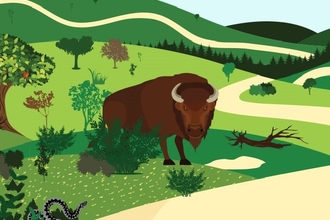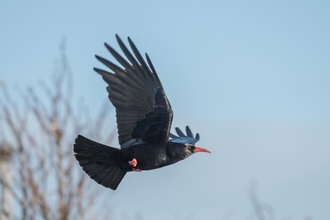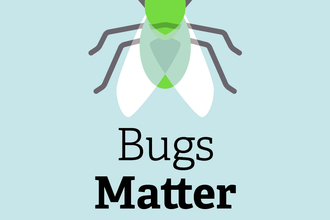What Are The Greensand Commons?
The Greensand Commons of Sevenoaks and Westerham share a rich history and have been a vital resource for local communities for generations. They are owned mainly by the Squerryes estate (Westerham) and Knole estate (Sevenoaks), and have been managed by local councils since 1925 and for the last 43 years by Sevenoaks District Council under a scheme of regulation. Sevenoaks Town Council owns and manages Sevenoaks Common. Sevenoaks Weald Village Commons being managed by Sevenoaks Weald Parish Council.
As well as being in an Area of Outstanding Natural Beauty (AONB), the Commons are Sites of Special Scientific Interest (SSSI) and/or Local Nature Reserves (LNR) for their areas of ancient woodland and open heathland. In addition, Hosey Common’s tunnelled quarry workings are important for bat species such as Daubenton’s, Natterer’s, whiskered/Brandt’s and brown long-eared bats.
The Commons cover nearly 300 hectares of varied habitats and are connected to the Greensand Way path, with links to the National Trust properties of Chartwell, Knole and Ightham Mote.
The Project Sites include:
The Westerham cluster (159ha):
This cluster is owned by Squerryes Estate and managed by Sevenoaks District Council.
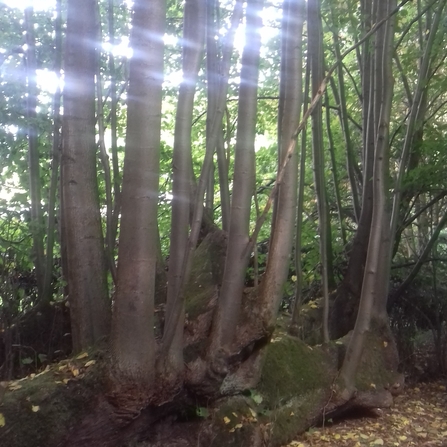
Hosey Common: Hosey Common is home to Westerham Mines, which provide a crucial roosting site for rare bat species, including Whiskered bat, Brandt’s bat and Brown long-eared bat. Napoleonic allotments also remain at Hosey Common, which were established on the commons in 1835.
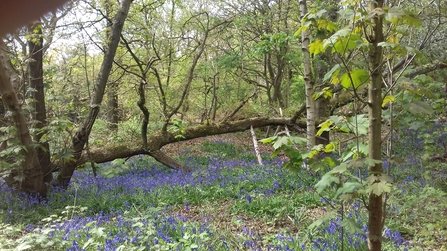
Farley Common: With well-developed paths throughout this site and near on street parking, Farley Common is easily accessible. This common boasts a rare habitat for West Kent: acid grassland. In the Spring, a carpet of bluebells appears throughout the woodland. This is an ideal site for families with young children to explore local wildlife.
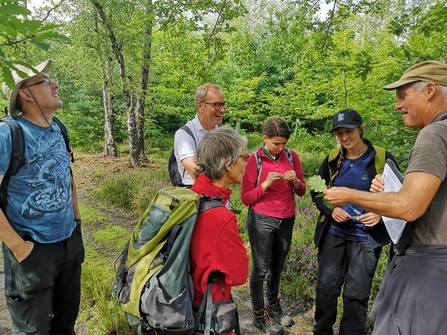
Crockham Hill Common: If you are a keen birder, Crockham Hill Common is a hidden gem. This unique yet quiet site is an excellent location for birdwatching. With fragments of heathland habitat throughout, this common is a refuge for West Kent’s lesser seen plant and animal species.
The Sevenoaks Cluster (22ha)
Sevenoaks Common was previously part of the Knole Estate who still own and lease Sevenoaks Weald Village Common.
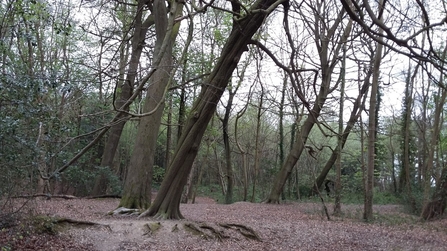
Sevenoaks Weald Village Common (managed by Sevenoaks Town Council): Sevenoaks Common is an easily accessible, quiet site. Badly hit by the Great Storm of 1987, the site has seen a huge effort to re-establish native tree species, which now support a wide range of birds, mammals, and insects.
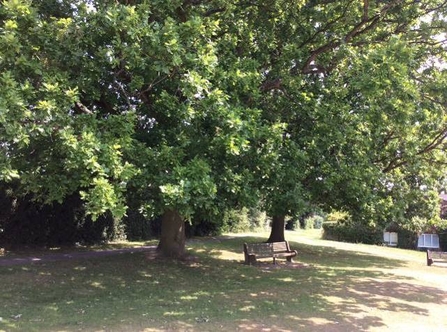
Sevenoaks Weald Common (managed by Sevenoaks Weald Parish Council): This small yet valuable common provides a home for wildlife in the heart of Sevenoaks Weald. Its quaint village location makes for a peaceful visit, with the offer of local pubs and independent businesses within walking distance.
The Seal cluster (115ha):
This cluster is owned by the Knole Estate and managed by Sevenoaks District Council.
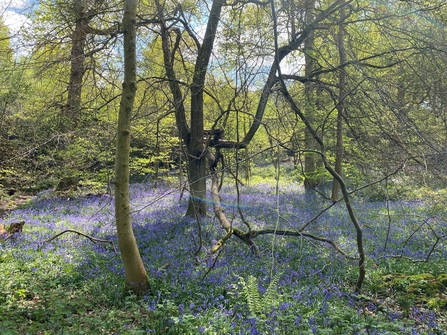
Bitchet Common: a beautiful site offering veteran trees and pockets of heathland habitat. Free local parking makes the site easily accessible, however, its hilly terrain presents a more challenging route, perfect for the avid walker.
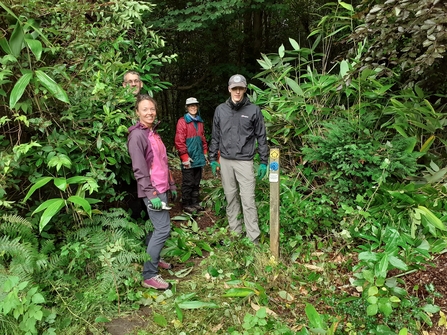
Fawke Common: Sitting adjacent to Knole Park, the wilder landscape of Fawke Common is truly a haven for Kentish wildlife. The woodland is alive from the ground to the tree canopy, providing a home to a variety of insects, fungi and birds.
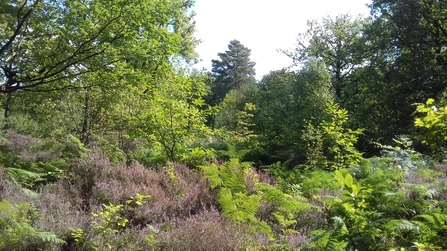
Seal Chart and Redhill Wood: With patches of open woodland throughout, Seal Chart and Redhill Wood are easily accessible. This site is known to support a wide variety of fungi species, which can be observed during Autumn.
Bye-laws and Scheme of Regulation
The commons are dedicated for free public access, on foot and on horseback.
Please see information relating to the 'Scheme' commons of Bitchet Common, Fawke Common, Seal Chart and Redhill Wood, Hosey Common, Farley Common and Crockhamhill Common below:
Get Involved
To find out more about the wider project and ongoing volunteering opportunities, please contact Head of Land Management, Simon Bateman-Brown:
Sevenoaks Greensand Commons Development Stage
For information please find the Consultation Survey Results which contains the collected responses to the consultation survey that took place this summer as part of the Development Stage. Thank you to everyone who has contributed to this process. The information gathered through this has informed the Stage 2 HLF funding application.
We have worked up a great project, secured a substantial amount of match funding, and further developed good working relationships with partners during this time. All of this has reinforced a strong application for the second stage funding application for the Delivery Stage which was submitted in February.
Aims and Objectives
The project aims to restore the landscape, social and natural heritage of the Commons, creating opportunities for people to engage with and use the sites in ways they would like. Through connecting with local schools, charities, community groups and council services, the project will help under-represented groups to access the Commons.
The project seeks to improve engagement by opening public access through 26km improved footpaths and bridleways. Clear signage will be introduced where possible, to help visitors to navigate and learn about the sites.
Improving the knowledge that local people have of the land and its management is integral to the project. Sharing practical skills and knowledge through volunteering opportunities and informal learning will empower communities to take on a lead role in the ongoing management of the Commons.
Sevenoaks District Council, working with Kent Wildlife Trust and others, secured £483,600 from the National Lottery Grants Heritage Fund and £48,970 from the Enovert Community Fund.
View the Proposed Projects and Activities.
Sevenoaks Greensand Commons Delivery Stage
In the years since the Development phase of the Project started, we have carried out extensive consultation with local people and organisations; we have brought together the main partners in the projects, visited other similar sites, talked to regular users of the Commons and introduced many more to the Commons, and carried out ecological surveys of all the sites.
Please see the bottom of the page for downloads of the Ecological Scoping & Outline Nature Conservation Management Plans for the project sites.
We have delivered a number of projects and activities that have actively engaged people in finding out more and learning about the Commons and physical works to enhance nature conservation and access.
People Engagement
Since entering its delivery stage, the project has seen remarkable success in engaging with local communities. Our engagement with residents of Sevenoaks, Westerham and Seal has been wide-ranging and has included events that are free, accessible via public transport and inclusive of underrepresented groups.
Kent Libraries
An exciting calendar of arts and crafts events has been delivered in local libraries, including pottery painting, card making and clay sculpture.
British Science Week Pot Painting and Oak Lifecycles, Sevenoaks Libraries
British Science Week 2022 promoted the theme of ‘Growth’. Our team celebrated this national event by hosting a free ‘Paint Your Own Plant Pot’ event at Sevenoaks Library for families, equipped with educational resources that helped children to learn about the lifecycle of the mighty oak tree!
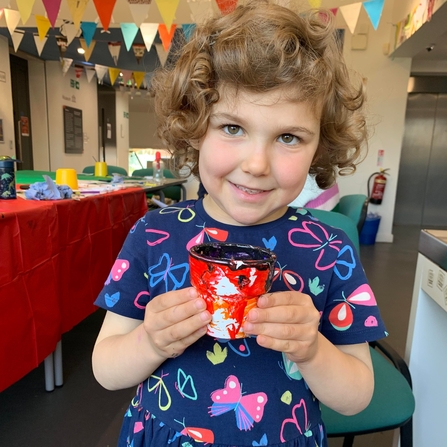
Clay Sculpting and Food Chains, Kemsing Library
Kemsing Library provided a venue for the project to deliver a morning of free clay sculpture for families. Children were given clay and tools to help them build hedgehog and slug figurines. After building their hedgehogs and slugs, they were able to roleplay a food chain!
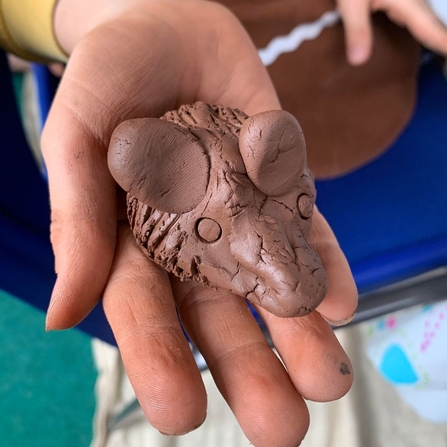
Butterfly ID and Painting at Westerham Library
Westerham Library helped the project to deliver a free ceramic butterfly painting event to families, which featured free educational resources for local sites, such as minibeasting hunts on Crockham Hill Common. The session also gave us the opportunity to promote our heathland restoration work and to highlight rare butterfly species that rely on the Commons.
Education and Employability
The project is networking with schools and colleges to provide assemblies, classroom activities and employability sessions. Our team have produced a menu of activities for schools, featuring activities that cover the habitats, plant and animal species of the Commons, the history of the Commons and information about their management. Local colleges have also received several employability skills workshops, with one-to-one tuition from our team on how to reach their conservation career goals.
Our team have also visited local Employment Fairs to promote volunteering opportunities in West Kent, and to raise awareness of careers in conservation and how to access them. In 2022, the project is collaborating with West Kent Housing Association to deliver virtual employability skills classes to local communities, encouraging nature-based careers.
Charity Collaborations
Several local charities have collaborated with the project, including The Prince's Trust and Arts Without Boundaries. Young people from The Prince’s Trust have joined the project for a day of holly thinning, sapling pulling and teambuilding exercises at Bitchet Common. The project has also collaborated with Arts Without Boundaries throughout 2022, providing educational and inclusive arts activities, such as a wildlife photography course and a woodland identification workshop that featured printmaking and a guided woodland walk (see below).
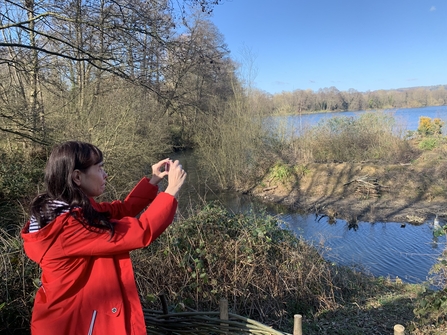
Care Homes
The project has worked extensively with Weald Heights Care Home in Sevenoaks to host a variety of educational talks and activities. These have included a ‘Bird Life of the Commons’ talk, followed by bird feeder making, and a ‘Butterflies of the Commons’ talk, followed by ceramic butterfly painting. Our team are also due to deliver activities soon to Forget-Me-Not Café in Westerham, to support local families caring for a loved one with dementia.
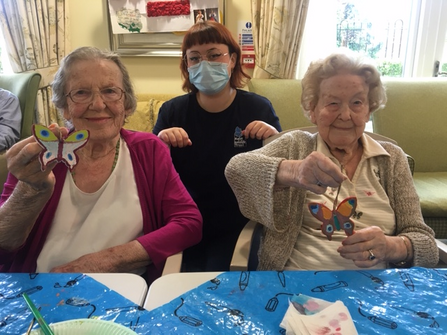
Conservation and Access
The project has worked closely with landowners, land managers and statutory bodies such as Natural England when planning works. Work has been delivered by a combination of contractors and a hugely dedicated group of volunteers. The National Lottery Heritage Fund requested a level of volunteer input which had a value of £60,000. We have met that target, so a huge ‘thank you’ to everyone who has contributed their time, knowledge and experience to the project. In turn, we have been able to support volunteers through training either informal or formal, including providing them with opportunities to gain Emergency First Aid, First Aid at Work, brush cutter and chainsaw certificates. Additionally, we provide some specialist walks and talks as a further ‘thank you’ for our volunteers.
One example of this work is the Bringing Back Bitchet Common Restoration Project, involving the restoration five-and-a-half hectares of heathland by removing rhododendron and birch, exposing the seeds from native heathland plants and allowing them to grow.
Geology of the Greensand Commons
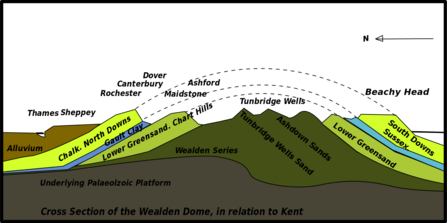
Simplified geological diagram of Wealden Dome © Clem Rutter
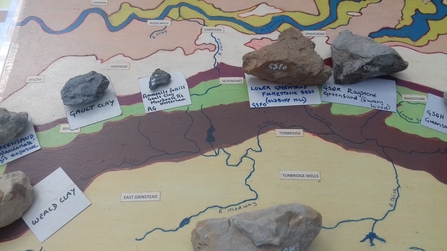
Geology of Greensand Commons, constructed by a volunteer.
The lower greensand formed in very shallow seas as the land was sinking. Particles of sand washed from the land were cemented together by lime in seawater. These formed bands of hard rock, compared to soft sandstone and mud of Weald to the south, and chalk of the North Downs.
Areas remaining on the plateau were left having very stony, slightly acidic, impoverished soils. Consequently, they were easy to clear of trees and vegetation, but very hard to farm.
Landscape History of the Greensand Commons
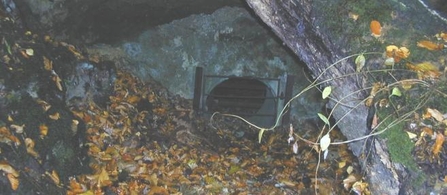
Hosey Common Westerham Mines
The geological makeup of the Commons has dictated past relationships between human beings and their natural environment. Whilst easy to clear of trees, but impossible to plough or farm, the landscape was worked. People collected wood for fuel and building materials, grazing their animals on the cleared land. Bracken and shrubs were harvested for bedding and they were even mined. Some of these management interventions had huge and positive impacts upon the biodiversity of the area e.g. the tradition of pollarding trees to head height have created ‘Veteran Trees’ – huge oak and beech trees, each providing an oasis for wildlife such as lichens and invertebrates, which in turn support wider eco-systems. The constant removal of brush for animal bedding and fuel from the Commons kept them cleared so the heathland species could thrive.
From the Iron Age, Romans, Saxons and Normans, all the way through to the 20th Century, people have all benefited from the Commons’ resources. Two significant Iron Age Hill Forts, (Crockham Hill and Oldbury) stand on the outside edge of the project area at the west and east ends of the Commons. Local historians believe there are also Roman tracks leading from Oldbury across Seal Chart to the south. Ragstone has been quarried from Hosey Common since the 12th Century and during the 1800’s miners from Bedfordshire came to mine the stone and stayed to join the local community. Some of this stone was used in the construction of Westminster Abbey and the Tower of London! The caves remain are now a Kent Wildlife Trust reserve for bats. Chert, another quarried stone, was extracted for tracks and roads and we can still see the extensive shallow quarries on our LiDAR survey. The Commons even have their own allotments… Kennedy Gardens, an area of land within Hosey Common which was ‘allotted’ to the poor families of the district whose husbands had fought for Britain in the Napoleonic wars.
Over the past two years a team of volunteer archaeologists have traversed the Commons looking at the lumps and bumps on the LiDAR survey. This survey allowed us to see under the tree canopy and revealed the extent of quarrying on the Commons. Distinctive shallow chert quarries could be seen across the landscape. The volunteer teams focused on Crockham Hill, Bitchet and Sevenoaks Commons with other highlights including:
- The boundary banks to the Commons (often lined with beech trees)
- The extensive earthworks around Squerryes Iron Age Hillfort
- World War Two training trenches
- Two possible medieval rabbit mounds
- Ponds, craters and unidentified pits
- Possible building platforms
- Old trackways and hollow ways
This survey work led to a series of trial excavations. At Bitchet Common we examined an old hollow way and several of the World War II training trenches. In the process of this work, we found a World War I Victory medal, which we still hope to trace back to the recipient’s family. At Fawke Common we investigated a post war bottle dump and on Crockham Hill we had a first look at our two possible pillow mounds…to be continued!
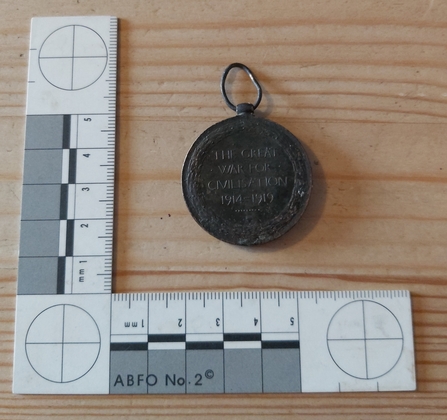
World War I Victory Medal, found at Crockham Hill Common.
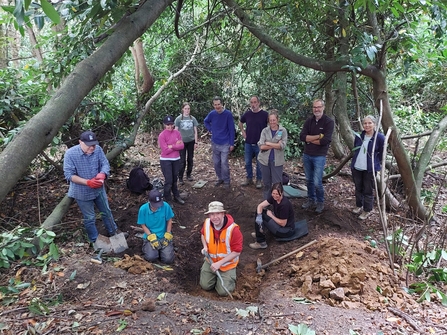
Volunteers helping the project’s Community Archaeologist to excavate an area of Crockham Hill Common.
Please see the Sevenoaks Greensand Commons Project Historic Review below which we have produced during this project.
Ecology of the Greensand Commons
The heathland habitat that can be found at the Commons is rarer than Amazonian rainforest!
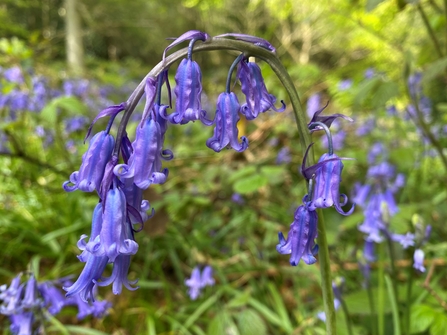
The Commons contain some unusual and rare habitats for Kent, and while much of the area is dominated by woodland, there are significant sections of acid grassland and heath habitat which is of high biodiversity value.
Valued Habitats
The project sites sit at the centre of Kent’s Biodiversity Opportunity Area (BOA) for the Greensand Heaths and Commons. Kent Nature Partnership’s BOA Statement highlights the importance of their acid grassland sites and “species of acid woodland and heathland which are otherwise scarce in Kent”.
Sites of Special Scientific Interest
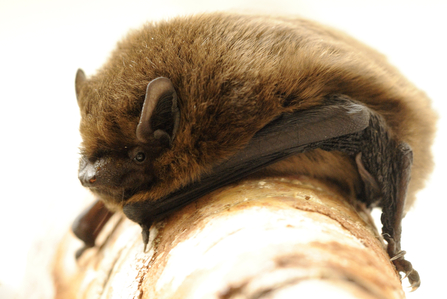
Many of the sites are designated Sites of Special Scientific Interest (SSSI). Hosey Common also contains tunnelled quarry workings, designated a SSSI as it is used by Daubenton’s, Natterer’s, whiskered/Brantd’s and brown long-eared bats.
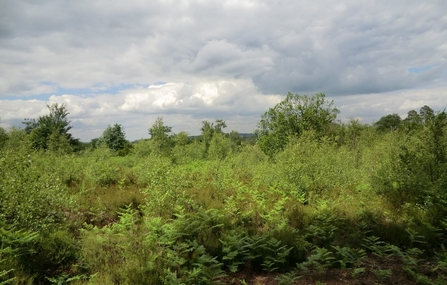
Areas where encroaching scrub have been cleared are now showing typical heathland plant species. Bracken, bramble and birch saplings still need ongoing management.
Species of Note
It is the mosaic of the Commons’ heathland habitat which provides a home to some less common plants and animals. For example, bilberry, wavy hair-grass, and ling can still be found in our Commons, but these plants, along with bird species such as nightjar, stonechat, woodlark, tree pipit and redstart have declined significantly as the more open habitats have been encroached upon.
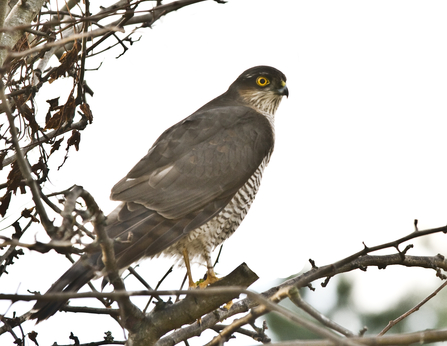
The Commons still supports a huge variety of wildlife such as green and great spotted woodpecker, buzzard, sparrowhawk and many small mammals including dormice and hedgehogs – animals which are “declining at a rapid rate” (British Hedgehog Preservation Society).
Wooded heaths are also home to a number of important indicator species such as green tiger and heath tiger beetles; and emperor, brindled beauty and deep brown dart moths, some of which are which are in some cases listed as priorities for the UK Biodiversity Action Plan (BAP):
The slug Tandonia rustica is only found here, alongside nationally scarce species of snails Acicula fusca and Rolph’s door snail, and Bitchet Common is the only known Kent site for the bristletail Dilta hibernica. Soft rush, greater bird’s foot trefoil lotus, red campion, hemp nettle, common fleabane, slender St. John’s wort and several fern species are found here, including lady fern.
We know that many of these species are still present in suitable habitats locally, but are no longer frequent on the commons.
Discovering the Butterflies of the Commons
Citizen science plays an important role in the project. In the summer of 2020, butterfly transects were set up at Hosey Common and Crockham Hill Common using the methodology of the UK Butterfly Monitoring Scheme.
Prior to the surveys, there were very few butterfly records for either of the Commons. In total, our volunteers recorded 20 species across the two sites, with 18 recorded at Crockham Hill Common and 12 at Hosey Common.
The White Admiral – a priority species - has been seen on both Hosey and Crockham Hill Commons. They fly from mid-June to mid-August and lay their eggs on honeysuckle that is in dappled shade.
The improvement works the project is undertaking on the Commons will encourage more native wildflowers to grow and provide a food source for both the butterflies and their larvae. The adults like open glades, therefore clearing along paths will produce a corridor to encourage them to move around to discover other food sources.
Project Site Maps
Locations of the Commons
The Commons are connected to the long distance Greensand Way path which runs along the ridge from Haslemere in Surrey to Hamstreet in Kent and connects the great National Trust properties of Chartwell, Knole and Ightham Mote.
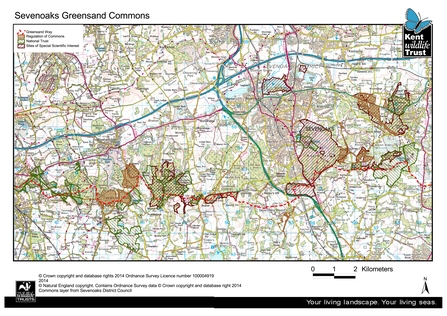
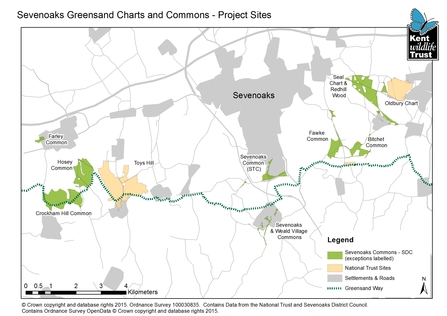
Sevenoaks Greensand Commons Project Sites
Project Partners
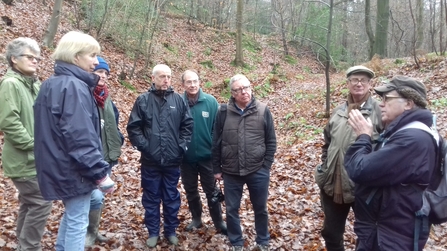
Members of the Steering Group and project partners at Hosey Common
Partnership working has been essential in developing the project and a wide range of partners provided input into the project to date. That support continues as we go through the ‘delivery stage’ of the project.
The project has, and continues to be developed and supported, with valued input from many organisations, including:
- Heritage Lottery Fund
- Kent Amphibian & Reptile Group
- Kent County Council
- Kent Downs AONB
- Knole Estate
- Natural England
- Open Spaces Society
- Seal Parish Council
- Sevenoaks District Council
- Sevenoaks Living Landscape
- Sevenoaks Society
- Sevenoaks Town Council
- Squerryes
- The Westerham Society
- Westerham Town Council
- Westerham Town Partnership
Walks around the Greensand Commons
Dotted throughout an Area of Outstanding Natural Beauty (AONB), the Greensand Commons of Sevenoaks, Westerham and Seal represent some of the best wild spaces that West Kent has to offer. These tranquil sites set the scene for a peaceful walk in nature that feature rare wildlife and local history. Explore ancient woodland, acid grassland and pockets of lowland heath as you walk the paths once travelled by generations dating back to the Iron Age!
You can download walking instructions, maps and GPX files here.
The project would like to say a special thank you to volunteer Adrian Wain, who kindly created these walks for local people to enjoy.
Resources
If you are a local educator, why not add raise awareness of the Sevenoaks Greensand Commons in your school? Our curriculum-relevant education pack for KS1 and KS2 covers learning outcomes from Geography, History and Science. Complete with lesson plans, worksheets and activities, you can use this pack to show your students the value of the rare habitats on their doorsteps.
